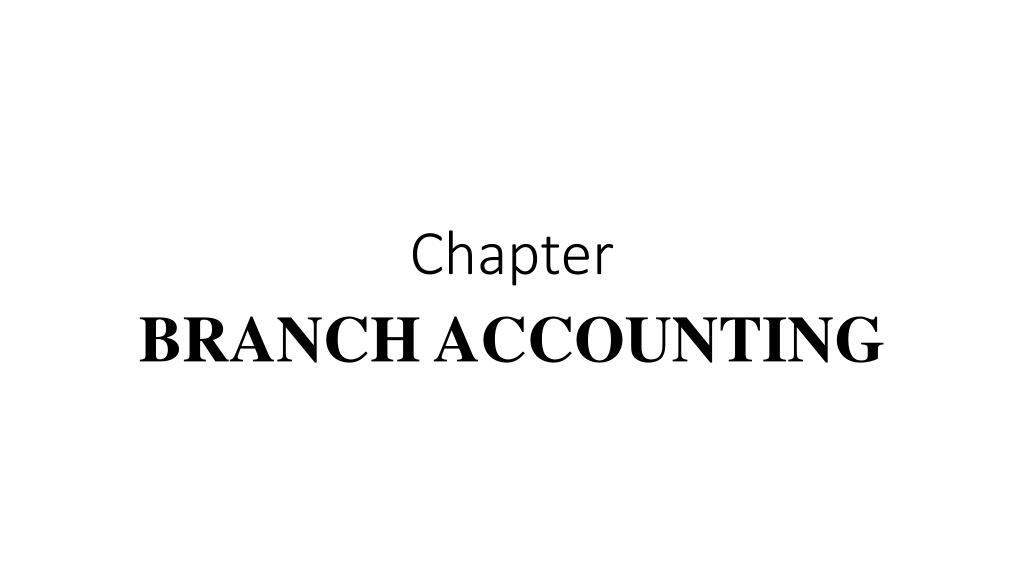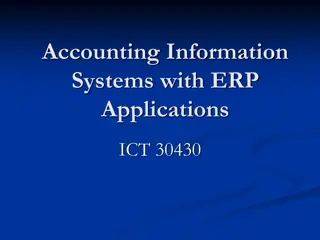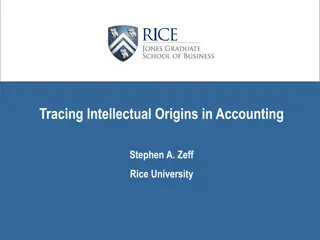Overview of Branch Accounting and its Importance in Business Operations
Branch accounting involves managing and tracking the financial activities of geographically separated branches within an enterprise. It helps in evaluating the profitability, financial position, and performance of each branch, determining the need for resources, and assessing the branch managers. Various types of branches such as home branches, dependent branches, independent branches, and foreign branches require specialized accounting techniques to effectively control their affairs. Understanding the different types of branches and accounting arrangements is crucial for maintaining accurate records and making informed business decisions.
- Branch Accounting
- Financial Management
- Profitability Analysis
- Business Operations
- Accounting Techniques
Download Presentation

Please find below an Image/Link to download the presentation.
The content on the website is provided AS IS for your information and personal use only. It may not be sold, licensed, or shared on other websites without obtaining consent from the author. Download presentation by click this link. If you encounter any issues during the download, it is possible that the publisher has removed the file from their server.
E N D
Presentation Transcript
Chapter BRANCH ACCOUNTING
Branch Definition: A section of an enterprise geographically separated from the rest of the business, control by the head office. Branch is an identical profit center. It is not a separate legal entity. Note: Specialized accounting techniques have to be adopted to control the affairs of the business. Differentiate Cost Center, profit center and Investment center.
Need for Branch Accounting: Ascertain the profitability of each branch. Know the financial position of each branch. Assess the performance. Profit or loss made by each branch Ascertain the requirement of cash, stock or asset of each branch. Know about the rate of return. Whether the brach shoud be closed of expanded. Asses the performance of branch manager. Ascertain the commission, bonus or remuneration of branch employees. Etc.
Types of Branches: Home Branches Dependent Branches (where head office maintains all the accounts) Independent Branches (where branches keeps its own record) Foreign Branches (trade independently and record their transiction in foreign currency)
Dependent branches Where the policies and administration of a branch are totally controlled by the head office, who also maintain its accounts. Types of dependent branches: Service Branches: booking and executing orders on behalf of head office. Accouniting record mainly consist of expenditures like salaries, wages, travelling expenses etc. petty cash to branch manager. Retail Selling Branch Head office maintains accounting record and manufacture/purchase the required stock and assets. Goods are sold by branch. Cash collected from customers are returned to the Head Office. Working fund is established for branch expenses.
Accounting Arrangement of Retail Branch Three main methods for recording Brach transactions. Debtors System Stock and Debtors System Final Accounting System.
Debtor System: Debtor System: (1 of 3) (1 of 3) This system is suitable for small-size branches A separate branch account is opened for each branch at the HO. Transactions are recorded in such a way that it show profit or loss. Goods may be sent at cost price or invoice price. Branch account is Debited with opening assets and credited with opening liabilities of the branch. Branch is then Debited expenses incurred, cash or goods sent by the H.O Branch Accounting is credited with goods returned, receipts from debtors and cash sales. At the end Branch Account is debited with branch s closing liabilities and credited with branch s closing assets. The difference between the debit and credit side represent profit or loss of branch.
Debtors System (2 of 3) The following items are to be ignored. Credit sales and relating matters such as bad debts, discount allowed etc. Depreciation on Assets. Petty cash expenses paid by the branch. Shortage or surplus on stock. Profit or loss on sales of FA. Purchases by branch. Note: For Branch account format and journal entries read book.
Debtors System (3 of 3) Branch account is nominal in nature. This method follow Balance Sheet approach in profit or loss determination. The difference in assets and liabilities represent the capital invested in branch. Note: The method of Branch Account preparation is same for cost and invoice price except for adjustment for loading (difference between cash and invoice price)
Stock and debtors system (1 of 3) This system is suitable when the branch size is large and goods are send to the branch at invoice price: Normally the following accounts are maintained Brach Stock account, Branch goods sent account, Branch adjustment account, Branch expenses account, Branch Debtors accounts, Branch Profit and loss account and Branch Fixed Assets account.
Stock and debtors system (2 of 3) Branch Stock Account: Invoice price is recorded. Opening balance, inflow and shortage is recorded at the debit side while closing, outflow and surplus on credit. Both side tally (because small fraction is adjusted as shortage or surplus) The purpose is to control branch stock. Branch goods sent account: Goods exchanged between branch and HO is recorded. Branch adjustment account: To ascertain the gross profit or loss of the branch. Summarize the load on all transactions. Excess of credit over debit side is gross profit and vice versa.
Stock and debtors system (3 of 3) Branch expenses account: All branch expenses paid in cash, bad debts, discount allowed, depreciation etc. The difference is transferred to the Branch profit and loss account. Branch Debtors accounts: When branch is allowed to sell on credit. Same method as debtors account. Branch Cash Account: Only in large branches to exercise greater control on branch cash. Branh Profit and Loss: To ascertain net profit or loss. Credited with gross profit (balance from stock adjustment account) and cost surplus while debited with branch expenses and cost of shortages, pilferage etc. Note: If the loss is normal, cost of such goods will be charged to Branch profit and loss account otherwise will be recorded in General Profit and Loss account. Please also read the recommended text book. Already shared.
Sales of Good Above/Below the Invoice Price Sometime the branch sell goods above/below the Invoice price, in such case the Branch Stock Account Does not balance. For adjustment purpose the following entry to be passed. When sold above the Invoice Price: Branch Stock Account To Branch Adjustment Account Dr. Cr. When Sold Below the Invoice Price: Branch Adjustment Account To Branch Stock Account Dr. Cr.
Final Account System: Head Office may prepare memorandum Branch Trading and Profit and Loss Account. All figures are converted on cost price. Incorporate those information which are ignored by the stock and debtor system. Branch is like a personal account in this system. Branch Trading and Profit and Loss account is memorandum in nature and the entries therein has no double-entry affect. Note: For detail read recommended text book, branch accounting, final account section.
Independent Branch When the size of branch is quite large and allowed by the HO to maintain its own record on double entry system. They are allowed to purchase goods from open market. The link between the branch and HO is that it is owned by the HO. After receiving the branch Trail Balance, consolidated financial statements are to be prepared for the entire enterprise. Special attention should be paid to Goods-in-transit Cash-in-transit HO expenses chargeable to Branch Depreciation on Branch Fixed Assets, and Inter-branch transactions
Incorporation of branch Trail Balance In HO Books If not incorporated the HO record will not show the correct position. Incorporation of Branch Profit and Loss Detailed Incorporation Abridged Incorporation Incorporation of Branch Assets and Liabilities
Detailed Incorporation Branch Trading and P & L Acc is prepared in HO. It is temporary in nature and record all revenue nature transactions. In this case double-entry system is not fully followed (for this account purpose already discussed). Abridge Incorporation: Under this system, a memorandum Trading and P & L acc is prepared for the purpose to ascertain the branch profit or loss. Only one entry is passed (instead of many) for incorporation purpose. Incorporation of Branch Assets and Liabilities: Incorporation is done to include the branch assets and liabilities in the annual balance sheet Note: For illustration and journal entries read text book s relevant pages.
Foreign Branches Accounting arrangements are same except treatment and adjustment of foreign currency. For incorporation of Branch trail balance in consolidate financial statements, it must translate the foreign currency figures in local currency, using the appropriate exchange rate. Fixed exchange rate to convert Trail Balance figures except for Remittances and Head office current account. Remittances are to be converted at actual rates at which they are made. Head office current account: at actual figures shown in the branch current account in HO books (after taking in consideration in-transit items) After conversion, a new trail balance takes birth, which may not tally. This difference is recorded in a separate account called Difference on Exchange Account .
Rules for Conversion when exchange rates are fluctuating. Rules for Conversion when exchange rates are fluctuating. Opening Stock: rate prevailing at the beginning of the period. Closing Stock: rate prevailing at the end of the period. Fixed Assets: Rate at the time of acquisition or on agreement. Fixed Liability: at the rate when it incurred. Current Assets and Current Liabilities: Rate at the time of Balance sheet. Revenue Items: assume that the occur evenly throughout the year, therefore average rate should be used. Depreciation: converted at the rate applicable to asset concerned. Remittances: actual rate at which made. Head office current account: at actual figures shown in the branch current account in HO books (after taking in consideration in-transit items) After conversion, a new trail balance takes birth, which may not tally. This difference is recorded in a separate account called Difference on Exchange Account .























